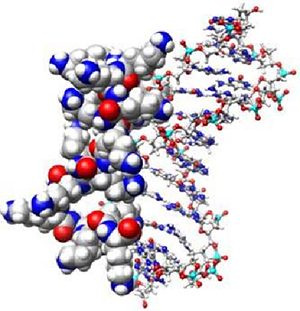INDIUM
Yongmei Wang

Dunavant Professor
Phone 901.678.2629 Email ywang@memphis.edu Fax 901.678.3447 Office 419 Smith Chemistry, Memphis, TN 38152 Office Hours Call for AppointmentResearch Interest
Theoretical and computational approaches to investigate underlying molecular processes in macromolecular systems and in nanomedicine.
Research Overview
Our group is interested in developing and applying theoretical and computational approaches to investigate underlying molecular processes in macromolecular systems and in nanomedicine. Over the years, we became involved in several different projects. Below gives a short summary of each project on how we began and what we have achieved and what we are currently focusing on.
Plasmonic Properties of Metallic Colloidal Particles
Metallic colloidal nanoparticles such as gold or silver have very interesting plasmonic
properties and have many interesting applications such as sensing or imaging. We became
involved in this area of study mostly because of Dr. Xiaohua Huang who joined us here
as a faculty member at Memphis. Dr. Huang worked with Prof. Mostafa El-Sayed during
her Ph.D. training at Georgia Tech and she developed bioconjugated gold nanorods to
kill cancer cells with photothermal therapy. Research activities in her group focus
on the use of these novel metallic nanoparticles in biomedical applications, and we
are intriqued in understanding the plasmonic properties of these metallic nanoparticles.
Together, we hope to establish a better structure-property relationship of these metallic
colloidal nanoparticles, particuarly those anistropic core-shell structured nanoparticles.
Polymer Based Gene delivery Polymer are often used as delivery vehicles in gene and drug delivery systems since
polymer chemists are capable of synthesizing and tailoring their srucutres in many
different ways. When gene therapy became possible since early 1990's, polymer was
sought after as a substitute of viral-based delivery vector since viral based delivery
vector poses unknown immune responses. The strucutral aspect of how cationic polymers
complex with nucleic acids and how these polymer cations assist in the successful
gene delivery is what we aim to get a fuller understanding. We have been working in
this area since 2008. Learn more about what we have achieved so far in this project
by following the link.
Polymer are often used as delivery vehicles in gene and drug delivery systems since
polymer chemists are capable of synthesizing and tailoring their srucutres in many
different ways. When gene therapy became possible since early 1990's, polymer was
sought after as a substitute of viral-based delivery vector since viral based delivery
vector poses unknown immune responses. The strucutral aspect of how cationic polymers
complex with nucleic acids and how these polymer cations assist in the successful
gene delivery is what we aim to get a fuller understanding. We have been working in
this area since 2008. Learn more about what we have achieved so far in this project
by following the link.
Current funding:
A) NSF Tennessee solar conversion and storage using outreach, research and education (TN-SCORE), NSF Epscor award (1004083), UT is the leading Institute, amount award to UM is $1.2 million for a total of five years (UM team members: Wang, Fujiwara, Zhao, Laradji, Mishra). 8/31/2010-7/31/2015, role: senior investigator. 1.0 person-months per year
B) Multiscale molecular modeling of polymer based gene delivery vector. NIGMS/NIH, $314,493, 06/01/2013-05/31/2016, role: PI, 1.2 person-months per year
C) Capture and Detection of Circulating Tumor Cells in Whole Blood Using Hybrid Nanoparticles and Microfluidic Devices, FedEx Institute of Technology Innovation Fund, role: co-PI (Huang is the PI), $122,919; 02/01/2014-6/30/2015; 0.5 person-months per year
Publication 2014-2015
1. Interplay of Coil-Globule Transition and Surface Adsorption of a Lattice HP Protein Model, Meng-bo Luo, Jesse D. Ziebarth, Yongmei Wang, J. Phys. Chem. B, 118, 14913-14921 (2014) (doi:10.1021/jp506126d)
2. Impact of Core Dielectric Properties on the Localized Surface Plasmonic Spectra of Gold-Coated Magnetic Core-Shell Nanoparticles. Chaffin EA, Bhana S, O'Connor RT, Huang X, Wang Y. J Phys Chem B. 118, 14076-14084 (2014). doi:10.1021/jp505202k.
3. Comparison of monovalent and divalent ion distributions around a DNA duplex with molecular dynamics simulation and a Poisson-Botlzmann approach, Timothy J. Robbins, Jesse D. Ziebarth, Yongmei Wang, Biopolymer, 101, 834-848 (2014) (doi:10.1002/bip.22461)
4. Capture and detection of cancer cells in whole blood with magnetic-optical nanoovals, Saheel Bhana, Elise A. Chaffin, Yongmei Wang, Sanjay R. Mishra, and Xiaohua Huang, Nanomedicine, 9, 593-606 (2014) (doi:10.2217/nnm.13.77)
5. HPLC characterization of hydrogenous polystyrene-b-deuterated polystyrene using isotope effect, Sanghoon Lee, Hyojoon Lee, Lam Thieu, Youncheol Jeong, Taihyun Chang, Chao Fu, Yutian Zhu, Yongmei Wang, Macromolecules, 46, 9114-9121 (2013) (doi:10.1021/ma4018247)
